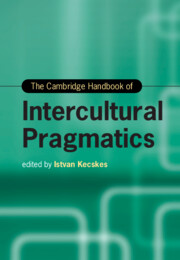Book contents
- The Cambridge Handbook of Intercultural Pragmatics
- Cambridge Handbooks in Language and Linguistics
- The Cambridge Handbook of Intercultural Pragmatics
- Copyright page
- Contents
- Figures
- Tables
- Acknowledgment
- Contributors
- Introduction The Rise of Intercultural Pragmatics
- Part I Theoretical Foundation
- 1 Post-Gricean Pragmatics for Intercultural Communication
- 2 Relevance Theory and Intercultural Communication
- 3 Cognitive Psychology in Pragmatics
- 4 The Theoretical Framework of Intercultural Pragmatics
- Part II Key Issues in Intercultural Pragmatics Research
- Part III Interface of Intercultural Pragmatics and Related Disciplines
- Part IV Intercultural Pragmatics in Different Types of Communication
- Part V Language Learning
- Index
- References
4 - The Theoretical Framework of Intercultural Pragmatics
from Part I - Theoretical Foundation
Published online by Cambridge University Press: 29 September 2022
- The Cambridge Handbook of Intercultural Pragmatics
- Cambridge Handbooks in Language and Linguistics
- The Cambridge Handbook of Intercultural Pragmatics
- Copyright page
- Contents
- Figures
- Tables
- Acknowledgment
- Contributors
- Introduction The Rise of Intercultural Pragmatics
- Part I Theoretical Foundation
- 1 Post-Gricean Pragmatics for Intercultural Communication
- 2 Relevance Theory and Intercultural Communication
- 3 Cognitive Psychology in Pragmatics
- 4 The Theoretical Framework of Intercultural Pragmatics
- Part II Key Issues in Intercultural Pragmatics Research
- Part III Interface of Intercultural Pragmatics and Related Disciplines
- Part IV Intercultural Pragmatics in Different Types of Communication
- Part V Language Learning
- Index
- References
Summary
The chapter presents the socio-cognitive approach (SCA) to communication that serves as a theoretical frame for intercultural pragmatics. SCA was developed to explain the specific features of intercultural interactions and thus offers an alternative to the Gricean approaches that can be considered monolingual theories. There are two important claims that distinguish SCA from other pragmatic theories. First, SCA emphasizes that cooperation and egocentrism are not antagonistic features of communication. While (social) cooperation is an intention-directed practice that is governed by relevance, (individual) egocentrism is an attention-oriented trait dominated by salience that refers to the relative importance or prominence of information and signs. Second, SCA claims that pragmatic theories have tried to describe the relationship of the individual and social factors by putting too much emphasis on idealized language use, and focusing on cooperation, rapport, and politeness while paying less attention to the untidy, messy, poorly organized and impolite side of communication. SCA pays equal attention to both sides. The first part of the chapter explains the main tenets of SCA. The second part discusses how context, common ground and salience are intertwined in meaning creation and comprehension. The chapter closes with suggestions for future research.
Keywords
- Type
- Chapter
- Information
- The Cambridge Handbook of Intercultural Pragmatics , pp. 83 - 104Publisher: Cambridge University PressPrint publication year: 2022



